Water Efficient Alternative Crops for Sustainable Agriculture along the Tarim Basin: A Comparison of the Economic Potentials of Apocynum pictum, Chinese Red Date and Cotton in Xinjiang, China
Abstract
:1. Introduction
- What is the institutional framework for the application of different crop types in this region?
- What is the cost-revenue structure of A. pictum, Chinese red date and cotton and which one is the most cost effective?
- What is the viability of the three aforementioned crop (A. pictum, cotton and Chinese red date) types under consideration of the institutional framework and the results of the economic analysis under global climate change?
2. Materials and Methods
2.1. Study Area
2.1.1. Cotton Production in Xinjiang and Tarim Basin
2.1.2. Chinese Red Date Cultivation in Tarim Basin
2.1.3. A. pictum and Artificial Cultivation
2.2. Analytical Framework
2.2.1. Property Rights of Natural Resources
2.2.2. Resources Use Types
2.3. Survey and Calculation Methods
3. Results
3.1. Property Rights in China
3.2. Resource Use Types of A. pictum
3.3. Cost-Revenue Analysis
4. Discussion
5. Conclusions
Acknowledgments
Author Contributions
Conflicts of Interest
References
- UN-Water. The United Nations World Water Development Report 4: Managing Water under Uncertainty and Risk; United Nations World Water Assessment Programme, UNESCO: Paris, France, 2012. [Google Scholar]
- Feike, T.; Ling, Y.K.; Mamitimin, Y.; Nan, H.; Lin, L.; Abdusalih, N.; Xiao, H.; Doloschutz, R. Determinants of cotton farmers’ irrigation water management in arid northwestern china. Agric. Water Manag. 2017, 187, 1–10. [Google Scholar] [CrossRef]
- Guo, Y.; Shen, Y. Agricultural water supply/demand changes under projected future climate change in the arid region of northwestern China. J. Hydrol. 2016, 540, 257–273. [Google Scholar] [CrossRef]
- Thevs, N.; Peng, H.Y.; Rouzi, A.; Zerbe, S.; Abdusalih, N. Water allocation and water consumption of irrigated agriculture and natural vegetation in the Aksu-Tarim river basin, Xinjiang, China. J. Arid Environ. 2014, 112, 87–97. [Google Scholar]
- Rouzi, A. Sustainable Land Use Alternative in the Tarim Basin, China. Ph.D. Dissertation, Catholic University of Eichstätt-Ingolstad, Eichstätt, Germany, 2016. [Google Scholar]
- Cyffka, B.; Rumbaur, C.; Kuba, M.; Disse, M. Sustainable management of river oases along the Tarim River (P. R. China) and the ecosystem services approach. Sustainability 2013, 6, 77–90. [Google Scholar]
- Thevs, N.; Zerbe, S.; Peper, J.; Succow, M. Vegetation and vegetation dynamics in the Tarim River floodplain of continental-arid Xinjiang, NW China. Phytocoenologia 2008, 38, 65–84. [Google Scholar] [CrossRef]
- Thevs, N.; Zerbe, S.; Schnittler, M.; Abdusalih, N.; Succow, M. Structure, reproduction and flood-induced dynamics of riparian Tugai forests at the Tarim River in Xinjiang, NW China. Forestry 2008, 81, 45–57. [Google Scholar] [CrossRef]
- Aishan, T.; Halik, U.; Kurban, A.; Cyffka, B.; Kuba, M.; Betz, F.; Keyimu, M. Eco-morphological response of floodplain forests (Populus euphratica Oliv.) to manmade water diversion in the lower reaches of Tarim River, Xinjiang, Northwest China. Environ. Earth Sci. 2013, 73, 533–545. [Google Scholar]
- Thevs, N.; Zerbe, S.; Kyosev, Y.; Rouzi, A.; Tang, B.; Abdusalih, N.; Novitskiy, Z. Apocynum venetum L. and Apocynum pictum Schrenk (Apocynaceae) as multi-functional and multi-service plant species in Central Asia: A review on biology, ecology, and utilization. J. Appl. Bot. Food Qual. 2012, 85, 159–167. [Google Scholar]
- Micklin, P. The future Aral Sea: Hope and despair. Environ. Earth Sci. 2016, 75, 844. [Google Scholar] [CrossRef]
- Mitchell, D.; Williams, R.B.; Hudson, D.; Johnson, P. A Monte Carlo analysis on the impact of climate change on future crop choice and water use in Uzbekistan. Food Secur. 2017, 9, 1–13. [Google Scholar] [CrossRef]
- Matios, E.; Burney, J.A. Ecosystem services mapping for sustainable agricultural water management in California’s central valley. Environ. Sci. Technol. 2017, 51, 2593–2601. [Google Scholar] [CrossRef] [PubMed]
- Hoppe, T. Chinesische Agrarpolitik und Uyghurische Agrarkultur im Widerstreit. Das Sozio-Kulturelle Umfeld von Bodenversalzungen und Alkalisierungen im Nördlichen Tarim-Becken (Xinjiang); Institut für Asienkunde: Hamburg, Germany, 1992. [Google Scholar]
- Thevs, N. Water Scarcity and Allocation in the Tarim Basin: Decision Structures and Adaptations on the Local Level. J. Curr. Chin. Aff. 2011, 40, 113–137. [Google Scholar]
- Gries, D.; Zeng, F.; Foetzki, A.; Arndt, S.K.; Bruelheide, H.; Thomas, F.M.; Zhang, X.M.; Runge, M. Growth and water relation of Tamarix ramosissima and Populus euphratica on Taklamakan desert dunes in relation to depth to a permanent water table. Plant Cell Environ. 2003, 26, 725–736. [Google Scholar] [CrossRef]
- Hou, P.; Carter, R.; Dong, X.; Li, X. Response to Environmental Flows in the Lower Tarim River, Xinjiang, China: Ground Water. J. Environ. Manag. 2007, 83, 371–382. [Google Scholar]
- Tang, D.; Deng, M. On the Management of Water Rights in the Tarim River Basin; Water Power Press: Beijing, China, 2010. [Google Scholar]
- Thevs, N.; Rouzi, A.; Kubal, C. Water consumption of agriculture and natural ecosystems along the Tarim river, China. GEOÖKO 2013, XXXIV, 50–76. [Google Scholar]
- Ling, Q.; Gao, X.; Zhao, X.; Huang, J.; Li, H.; Li, L. Soil water effects of agroforestry in rainfed jujube (ziziphus jujube, mill.) orchards on loess hillslopes in northwest china. Agric. Ecosyst. Environ. 2017, 247, 343–351. [Google Scholar]
- Song, Y.D.; Fan, Z.L.; Lei, Z.D.; Zhang, F.W. Research on Water Resources and Ecology of Tarim River, China; Xinjiang Peoples Press: Urumqi, China, 2000. [Google Scholar]
- Mamitimin, Y.; Feike, T.; Doluschitz, R. Bayesian network modeling to improve water pricing practices in northwest China. Water 2015, 7, 5617–5637. [Google Scholar] [CrossRef]
- Shangguan, D.; Liu, S.; Ding, Y.; Ding, L.; Xu, J.; Jing, L. Glacier changes during the last forty years in the Tarim Interior River basin, northwest China. Prog. Nat. Sci. 2009, 19, 727–732. [Google Scholar] [CrossRef]
- Hao, X.; Chen, Y.; Xu, C.; Li, W. Impacts of Climate Change and Human Activities on the Surface Runoff in the Tarim River Basin over the Last Fifty Years. Water Resour. Manag. 2007, 22, 1159–1171. [Google Scholar] [CrossRef]
- Tao, H.; Gemmer, M.; Bai, Y.; Su, B.; Mao, W. Trends of streamflow in the Tarim River Basin during the past 50years: Human impact or climate change? J. Hydrol. 2011, 400, 1–9. [Google Scholar] [CrossRef]
- Zhao, R.; Chen, Y.; Shi, P.; Zhang, L.; Pan, J.; Zhao, H. Land use and land cover change and driving mechanism in the arid inland river basin: A case study of Tarim River, Xinjiang, China. Environ. Earth Sci. 2012, 68, 591–604. [Google Scholar] [CrossRef]
- Feike, T.; Mamitimin, Y.; Li, L.; Doluschitz, R. Development of agricultural land and water use and its driving forces along the Aksu and Tarim River, P.R. China. Environ. Earth Sci. 2014, 73, 517–531. [Google Scholar] [CrossRef]
- Zhao, X.; Tisdel, C. The Sustainability of Cotton Production in China and in Australia: Comparative Economic and Environmental Issues; Working Paper, (No. 157); University of Queensland: Brisbane, Australia, 2009. [Google Scholar]
- Chapagain, A.K.; Hoekstra, A.Y.; Savenje, H.H.G.; Gautam, R. The water footprint of cotton consumption: An assessment of the impact of worldwide consumption of cotton products on the water resources in the cotton producing countries. Ecol. Econ. 2006, 60, 186–203. [Google Scholar] [CrossRef]
- ICTSD. Cotton: Trends in Global Production, Trade and Policy, 2013. Geneva, Switzerland. Available online: www.ictsd.org (accessed on 9 September 2017).
- XJSYB. Xinjiang Statistical Yearbook 2012; China Statistical Press: Beijing, China, 2012. [Google Scholar]
- Ouyang, J.Q. Analysis and countermeasure of the supply and need of water resources in Xinjiang. Econ. Trib. 2008, 73, 40–42. (In Chinese) [Google Scholar]
- Zhang, C. Cotton Disaster and Disaster Prevention and Reduction Techniques; China Agricultural Scientech Press: Beijing, China, 2001. (In Chinese) [Google Scholar]
- Adams, G.; Boyd, S.; Huffman, M. The Economic Outlook for US Cotton 2014; National Cotton Council of America: Washington, DC, USA, 2015; 63p, Available online: http://www.cotton.org/econ/reports/upload/2014-Annual-Outlook.pdf (accessed on 22 December 2017).
- Jin, X. Developing Red Dates to Promote Xinjiang Agricultural Innovation, 11–13. In Proceedings of the International Conference on Environment, Agriculture and Food Sciences (ICEAFS’2012), Phuket, Thailand, 11–12 August 2012. [Google Scholar]
- Yao, S. Past, Present, and Future of Jujubes—Chinese Dates in the United States. Hort Sci. 2013, 48, 672–680. [Google Scholar]
- Shi, Y.; Feng, H. Development prospect and counterplan of Ziziphus jujube in Xinjiang. Xinjiang Agric. Sci. 2005, 6, 14–18. (In Chinese) [Google Scholar]
- He, R.Y.; Chu, J.P.; Chen, G.L. Chinas Fiber Crops. China’s Fiber Crops 1997, 19, 21–23. [Google Scholar]
- Berljand, S. Agro-Technology of Kendir; NAUK (USSR Academy of Sciences Publishing House): Moscow, Soviet Union, 1950. (In Russian) [Google Scholar]
- Ma, Y.; Chen, Y. Observation on the antiaging, anti-hypertensive and anti-hyperlipidemic effect of Apocynum venetum leaf extract. Chin. J. Mod. Dev. Tradit. Med. 1999, 9, 335–337. [Google Scholar]
- Zhang, W.; Xiao, Z.; Zhang, G.; Gu, G. Study on ecotype of Apocynum in Xinjiang and its fiber quality. Chin. Wild Plant Resour. 2006, 25, 33–37. [Google Scholar]
- Wang, L.; Han, G.; Zhang, Y. Comparative study of composition, structure and properties of Apocynum venetum fibers under different pretreatments. Carbohydr. Polym. 2007, 69, 391–397. [Google Scholar] [CrossRef]
- Zhang, S. The division of geographical on distribution region of Kendyr in China. Plant J. Northwest China 2002, 22, 1–5. [Google Scholar]
- Ostrom, E.; Schlager, E. The Formation of Property Rights. In Rights to Nature: Ecological, Economic, Cultural, and Political Principles of Institutions for the Environment; Hanna, S.S., Folke, C., Mäler, K.-G., Eds.; Island Press: Washington, DC, USA, 1996; pp. 127–156. [Google Scholar]
- Tisdell, C. Economics of Environmental Conservation, 2nd ed.; Edward Elgar: Cheltenham, UK, 2005. [Google Scholar]
- Hardin, G. The tragedy of the commons. Science 1968, 162, 1243–1248. [Google Scholar] [CrossRef] [PubMed]
- Schlager, E.; Ostrom, E. Property-rights regimes and natural resources: A conceptual analysis. Land Econ. 1992, 68, 249–262. [Google Scholar] [CrossRef]
- Bekes, F. Social Systems, Ecological Systems and Property rights. In Rights to Nature: Ecological, Economic, Cultural, and Political Principles of Institutions for the Environment; Hanna, S.S., Folke, C., Mäler, K.-G., Eds.; Island Press: Washington, DC, USA, 1996; pp. 127–156. [Google Scholar]
- Tisdel, C. Notes on Market Failure and the Paretian (Kaldor-Hicks) Relevance and Irrelevance of Unfavorable Externalities; Economics, Ecology and Environment Working Papers; University of Queensland: Brisbane, Australia, 2003; pp. 1–10. [Google Scholar]
- Ritchie, J.; Lewis, J. Qualitative Research Practice; SAGE Publications: London, UK, 2003. [Google Scholar]
- Hilmi, M. Economic Concepts in Market-Oriented Farming; Agromisa 2004: Wageningen, The Netherlands, 2006. [Google Scholar]
- OECD. OECD Stat Library. 2017. Available online: http://stats.oecd.org/Index.aspx?querytype=view&queryname=221 (accessed on 9 September 2017).
- Barbier, E. Natural Resources and Economic Development; Cambridge University Press: New York, NY, USA, 2007. [Google Scholar]
- Dean, R.; Damm-Luhr, T. Current Review of Chinese Land-Use Law and Policy: A Breakthrough in Rural Reform. Pac. Rim Law Policy J. Assoc. 2010, 19, 121–159. [Google Scholar]
- Kung, K.; Liu, S. Farmers’ Preferences regarding Ownership and Land Tenure in Post-Mao China: Unexpected Evidence from Eight Counties. China J. 1997, 38, 33–64. [Google Scholar] [CrossRef]
- Mullan, K.; Grosjean, P.; Kontoleon, A. Land Tenure Arrangements and Rural–Urban Migration in China. World Dev. 2011, 39, 123–133. [Google Scholar] [CrossRef]
- Liu, S.; Carter, M.R.; Yao, Y. Dimensions and diversity of property rights in rural China: Dilemmas on the road to further reform. World Dev. 1998, 26, 1789–1806. [Google Scholar] [CrossRef]
- Ho, P. Institutions in Transition Land Ownership, Property Rights, and Social Conflict in China; Oxford University Press: New York, NY, USA, 2005. [Google Scholar]
- Zhang, L.; Li, H.Q.; Yi, H.Y. Botanical characteristics, distribution and application of Lopnur Kender resources in Aksu prefecture. Xinjiang Agric. Sci. 2003, 40, 172–174. [Google Scholar]
- MacDonald, S.; Gale, F.; Hansen, J. A Report from the Economic Research Service-Cotton policy in China. 2015. Available online: http://www.ers.usda.gov. CWS-15c-01 Mar 2015 (accessed on 9 September 2017).
- Xinjiang UAR Development and Reform Committee. Xinjiang Agricultural Cost-revenue Material; Xinjiang UAR Development and Reform Committee: Urumqi, China, 2013.
- National Bureau of Statistics of China. China Statistical Year Book, 2013; China Statistical Press: Beijing, China, 2013.
- Palmer, M.A.; Zedler, J.B.; Falk, D.A. Foundations of Restoration Ecology, 2nd ed.; Island Press: Washington, DC, USA, 2016. [Google Scholar]
- Zhu, Y.; Chen, Y.; Ren, L.; Lü, H.; Zhao, W.; Yuan, F. Ecosystem restoration and conservation in the arid inland river basins of northwest china: Problems and strategies. Ecol. Eng. 2016, 94, 629–637. [Google Scholar] [CrossRef]
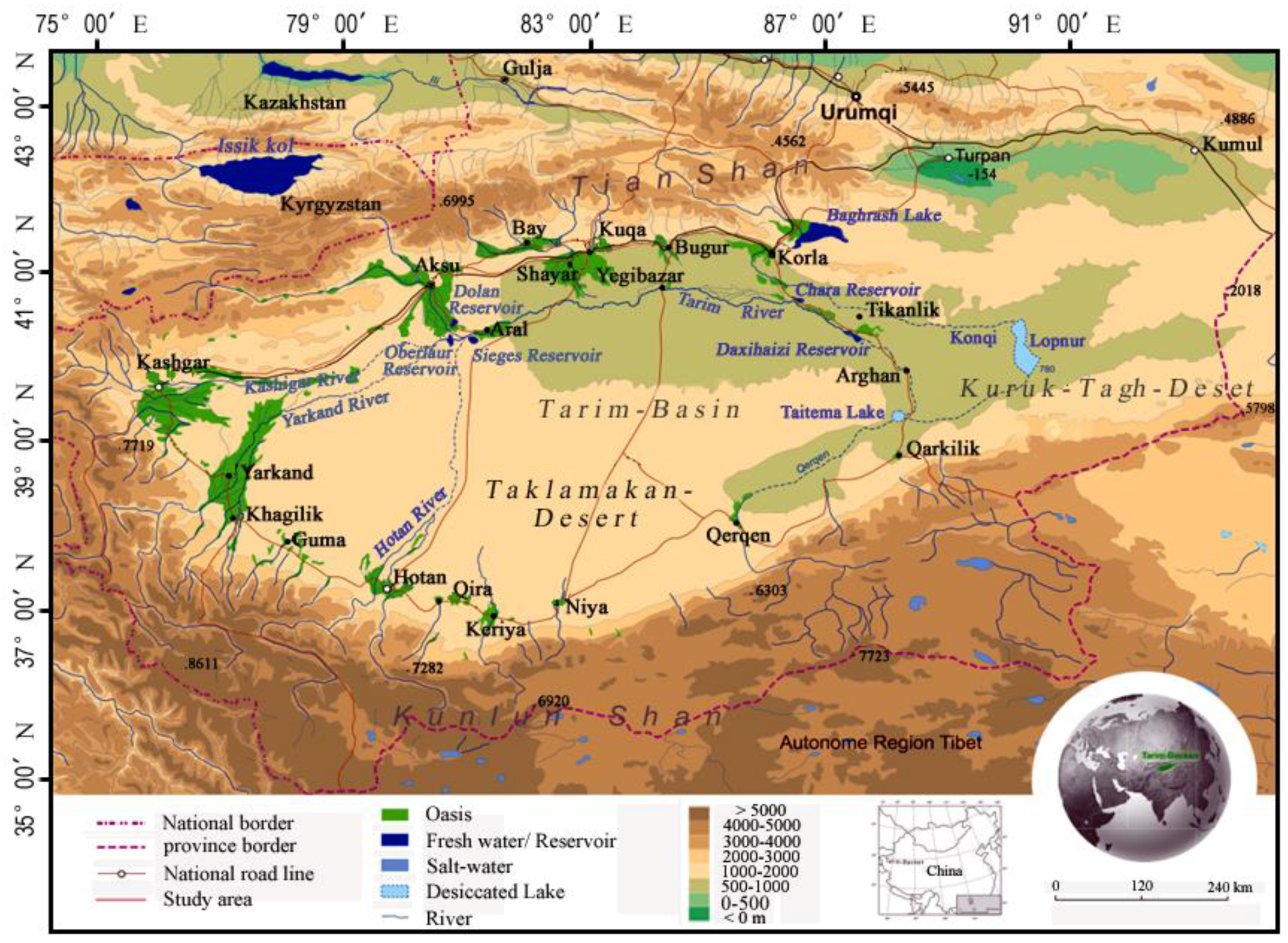
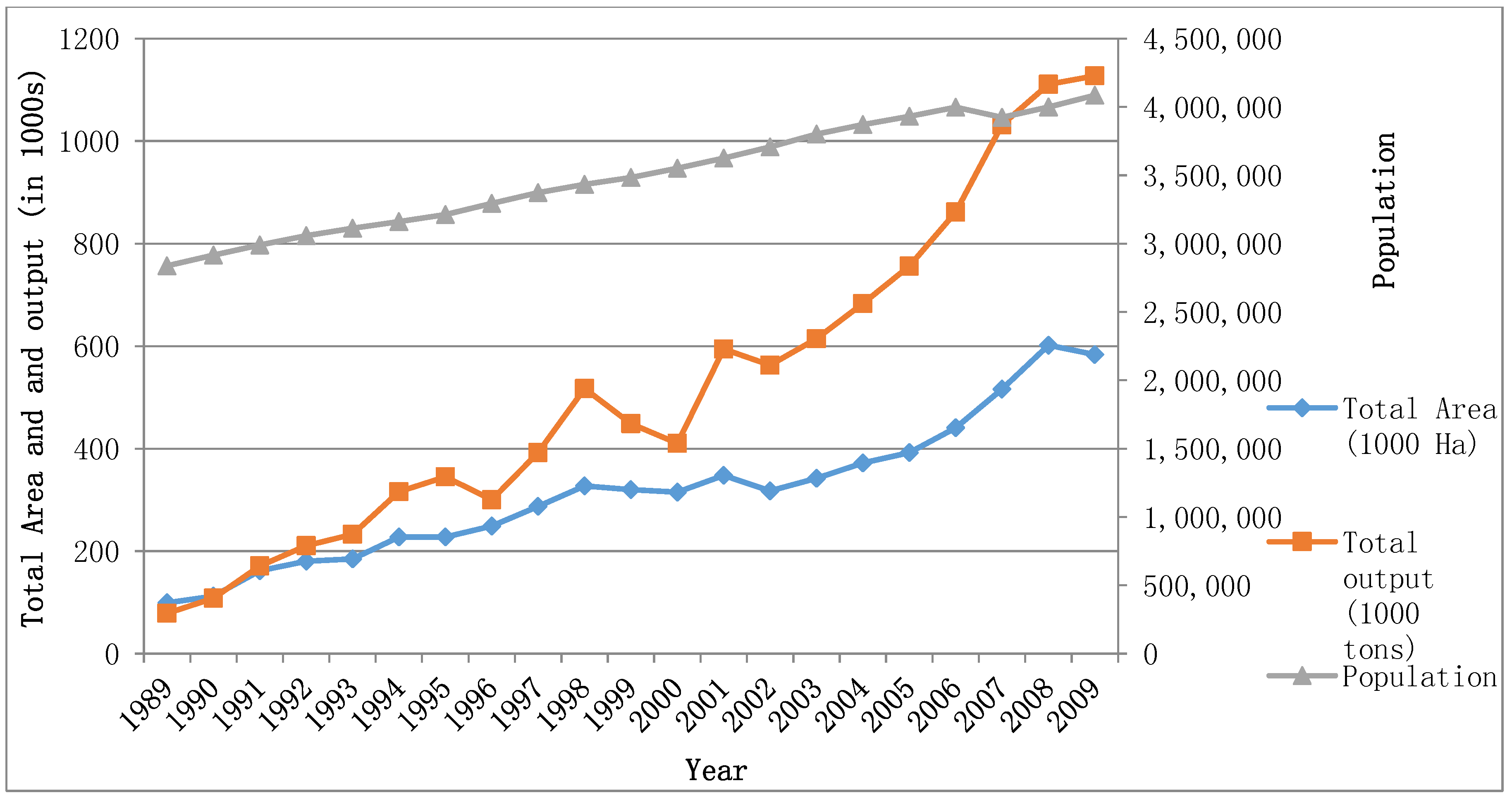
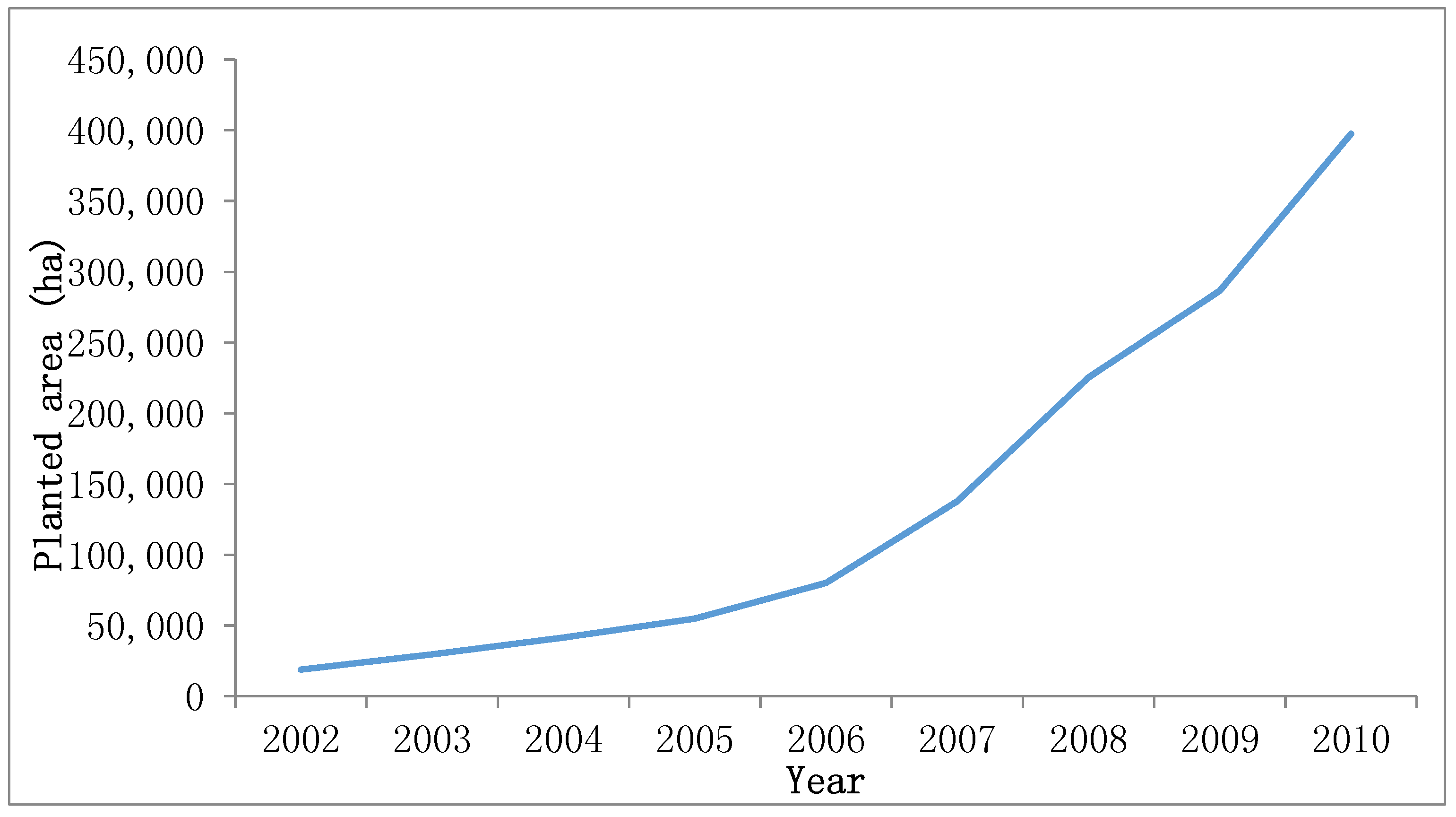
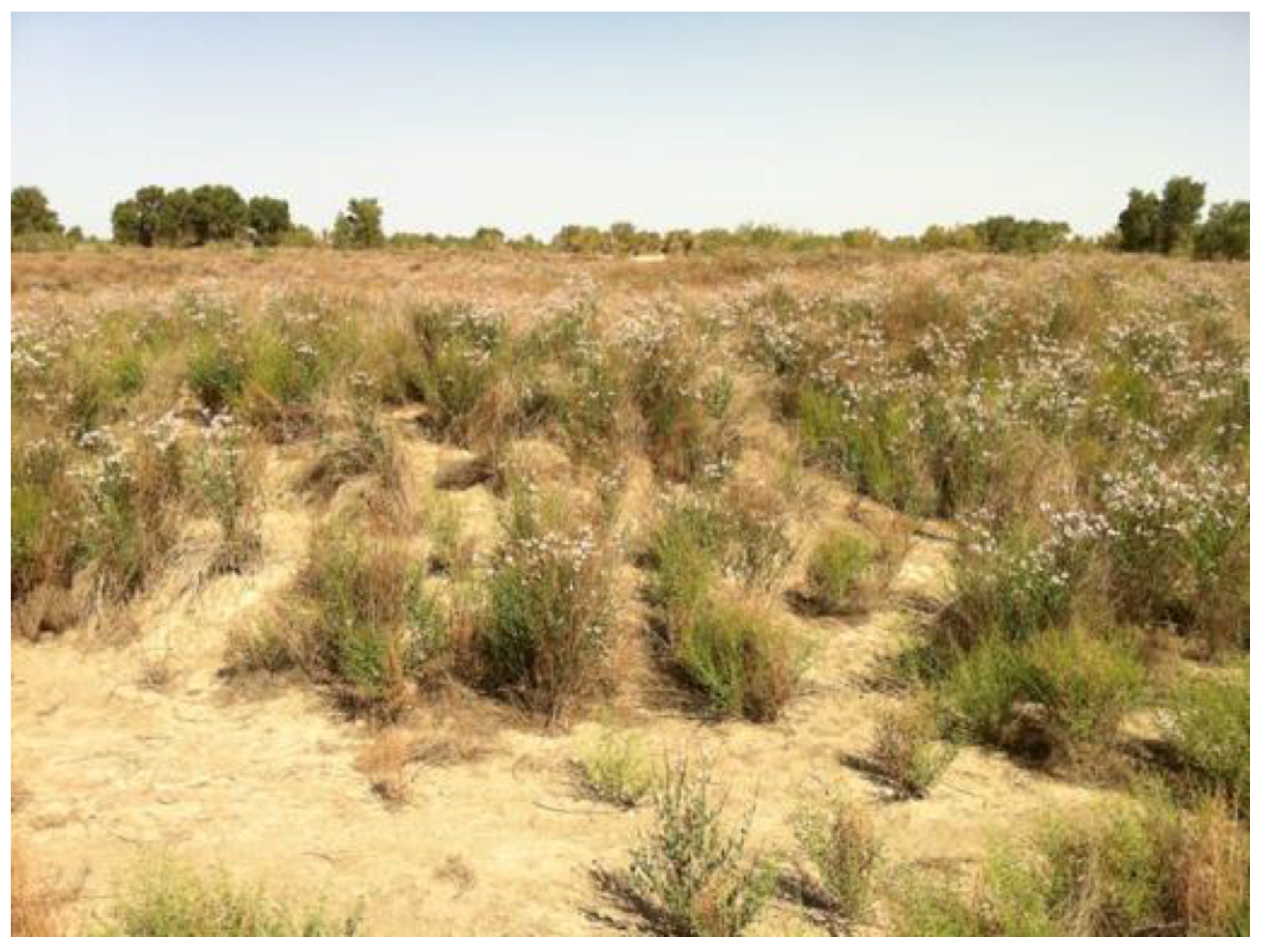
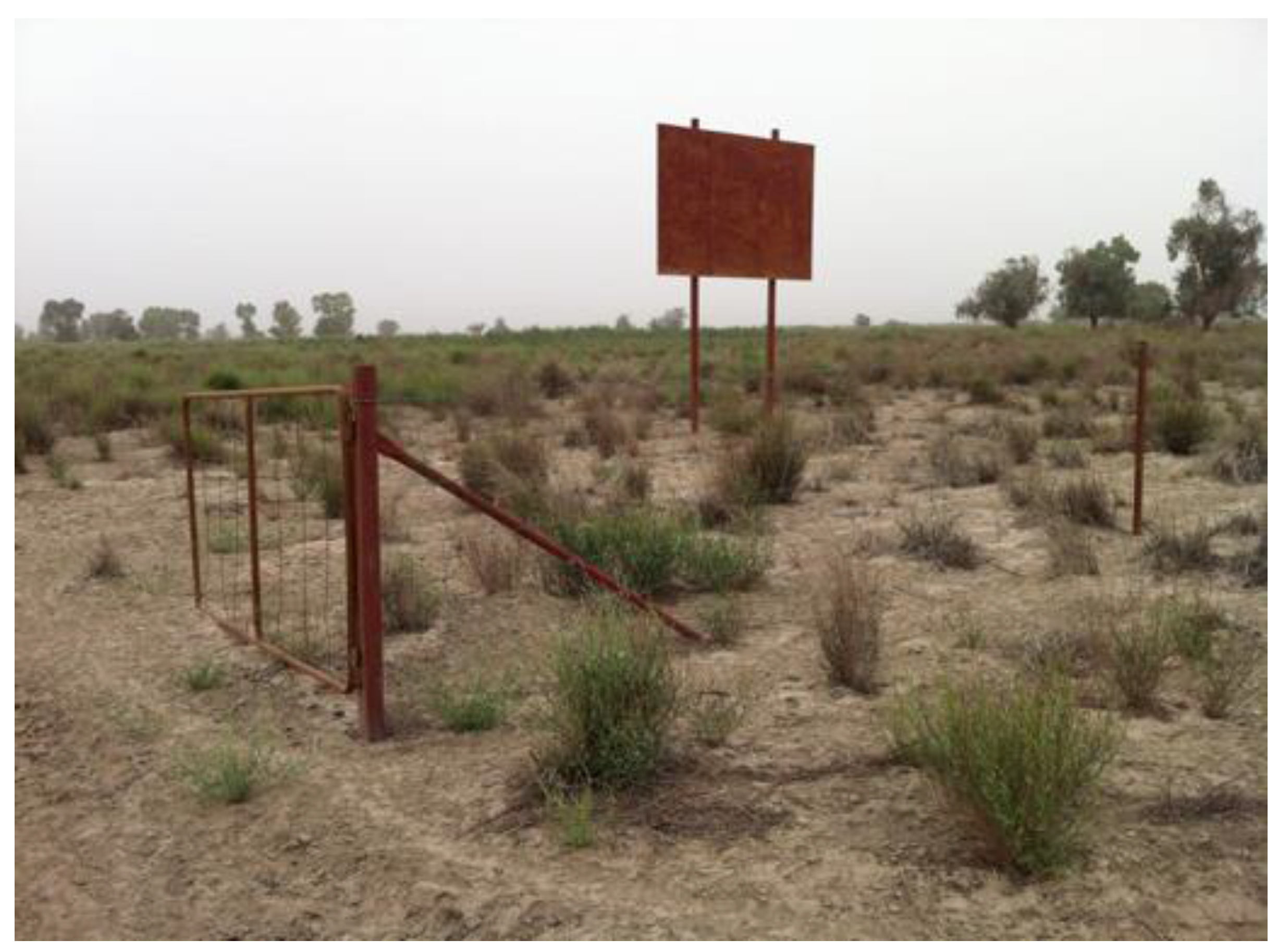
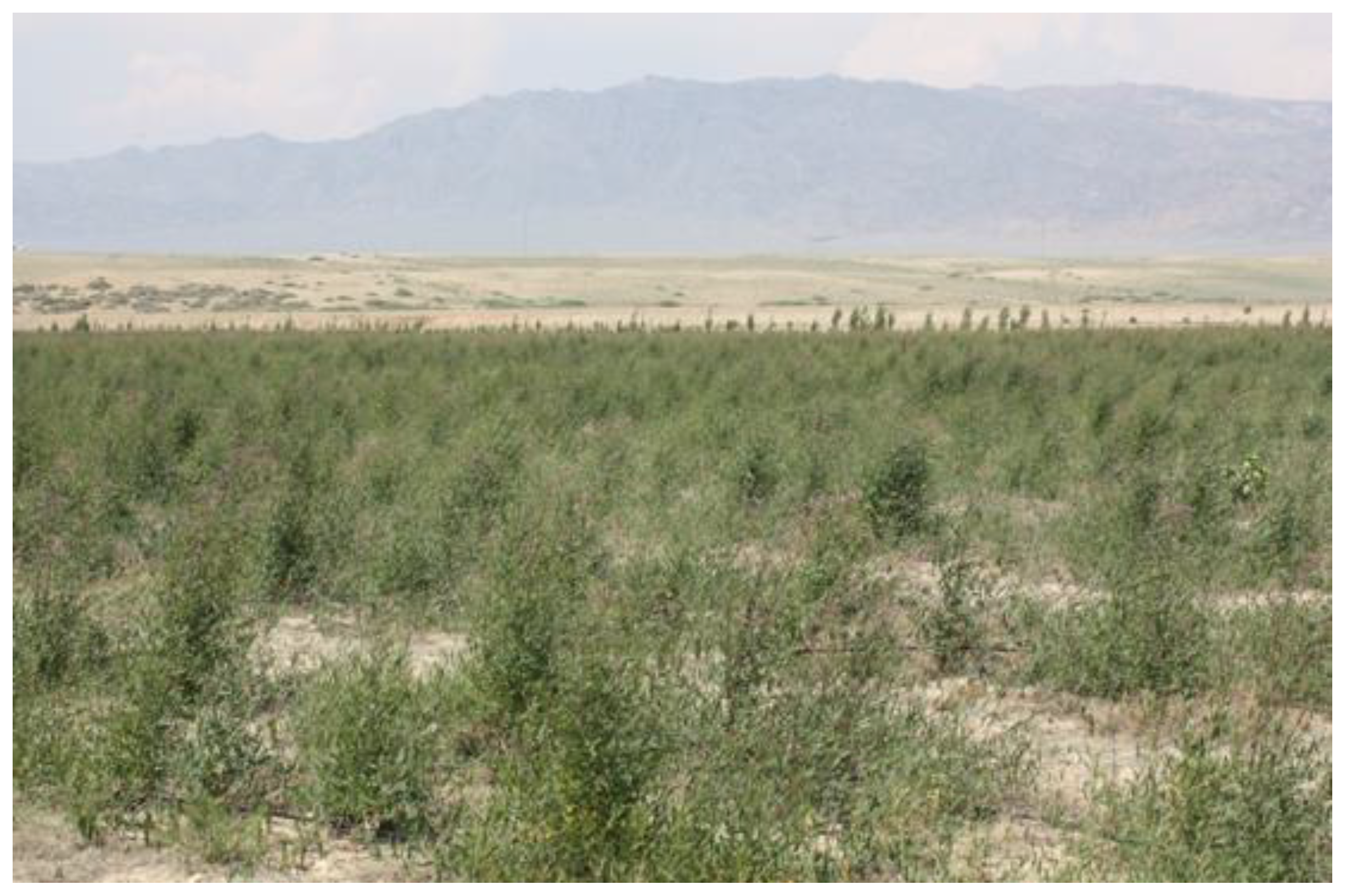
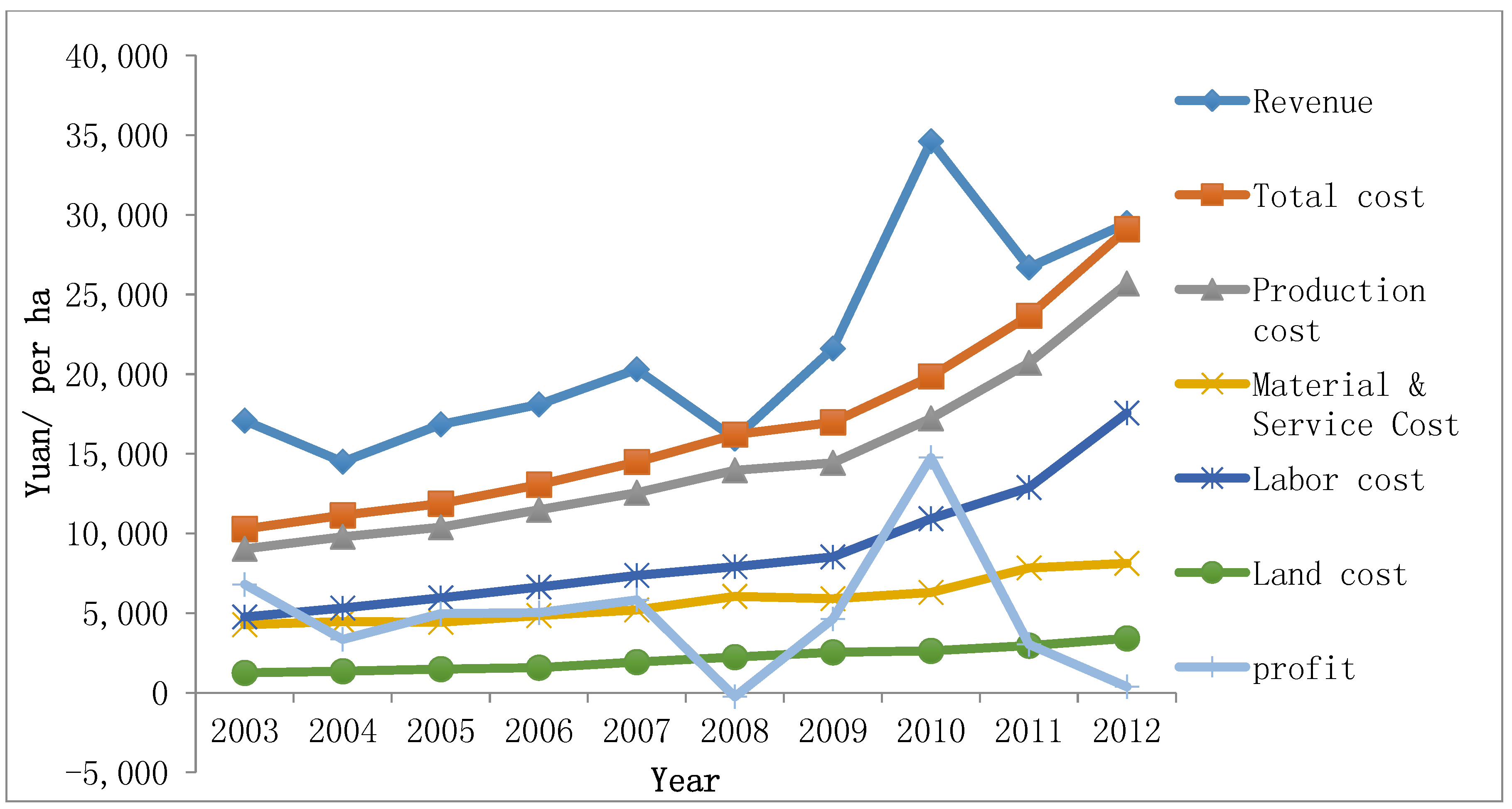
| Raw Material or Products | Yields (kg/ha) | Single Price yuan/kg | Potential Total Revenue = Production × Single Price (yuan/ha) |
|---|---|---|---|
| Stem | 3075 | 7.79 | 23,954.25 |
| Leaf | 1680 | 7.81 | 13,120.8 |
| Flower | 330 | 36.18 | 11,939.4 |
| Raw Material Total | 5085 | 49,014.45 | |
| Tea | 1125 | 146.52 | 164,835 |
| Fiber | 330 | 97.59 | 32,204.7 |
| Farming N = 7 | Ranching N = 9 | Open Access N = 9 | |||
|---|---|---|---|---|---|
| Fixed Costs | Fixed Costs | Fixed Costs | |||
| Land Lease | 0 | Land Lease | 0 | ||
| Tractor | 0 | Fencing (yuan/ha) | 1995 | ||
| Variable Costs | Variable Costs | Variable Costs | |||
| Planting and site establishment yuan/ha (Includes labor) | 1224 | Harvesting Labor yuan/Person/a day/ha | 2362.2 | Harvest Labor (yuan) | 2362.2 |
| Harvest labor yuan/Person/a day/ha | 2362.2 | Transportation yuan/Mu of yield | 1109.85 | Transportation (yuan) | 1109.85 |
| Water fee yuan/ha/Irrigation | 2998.5 | ||||
| Transport yuan/ha of yield | 1109.85 | ||||
| Fertilizer (yuan/ha) | 4055.7 | ||||
| Irrigation and weeding labor (yuan) | 4500 | ||||
| Per ha total costs | 16,250.25 | Per ha total costs | 5467.05 | Per ha total costs | 3472.05 |
| Name | Cotton in Xinjiang | Cotton in China | Chinese Red Date in Xinjiang | A. pictum |
|---|---|---|---|---|
| Cost (yuan/ha) | 28,898.7 | 29,095.95 | 43,396.95 | 16,250.25 |
| Revenue (yuan/ha) | 37,114.95 | 29,474.85 | 56,210.4 | 49,014.45 |
| Profit (yuan/ha) | 8216.25 | 378.9 | 12,813.45 | 32,764.2 |
| Output (Kg/ha) | 1719.75 | 2491.5 | 2128.05 | 5085 |
| Source | Xinjiang Agricultural cost-revenue material 2013 [61] | Chinese Statistical Yearbook 2013 [62] | Xinjiang Agricultural cost-revenue material 2013 [61] | This study |
© 2017 by the authors. Licensee MDPI, Basel, Switzerland. This article is an open access article distributed under the terms and conditions of the Creative Commons Attribution (CC BY) license (http://creativecommons.org/licenses/by/4.0/).
Share and Cite
Rouzi, A.; Halik, Ü.; Thevs, N.; Welp, M.; Aishan, T. Water Efficient Alternative Crops for Sustainable Agriculture along the Tarim Basin: A Comparison of the Economic Potentials of Apocynum pictum, Chinese Red Date and Cotton in Xinjiang, China. Sustainability 2018, 10, 35. https://doi.org/10.3390/su10010035
Rouzi A, Halik Ü, Thevs N, Welp M, Aishan T. Water Efficient Alternative Crops for Sustainable Agriculture along the Tarim Basin: A Comparison of the Economic Potentials of Apocynum pictum, Chinese Red Date and Cotton in Xinjiang, China. Sustainability. 2018; 10(1):35. https://doi.org/10.3390/su10010035
Chicago/Turabian StyleRouzi, Aihemaitijiang, Ümüt Halik, Niels Thevs, Martin Welp, and Tayierjiang Aishan. 2018. "Water Efficient Alternative Crops for Sustainable Agriculture along the Tarim Basin: A Comparison of the Economic Potentials of Apocynum pictum, Chinese Red Date and Cotton in Xinjiang, China" Sustainability 10, no. 1: 35. https://doi.org/10.3390/su10010035
APA StyleRouzi, A., Halik, Ü., Thevs, N., Welp, M., & Aishan, T. (2018). Water Efficient Alternative Crops for Sustainable Agriculture along the Tarim Basin: A Comparison of the Economic Potentials of Apocynum pictum, Chinese Red Date and Cotton in Xinjiang, China. Sustainability, 10(1), 35. https://doi.org/10.3390/su10010035









